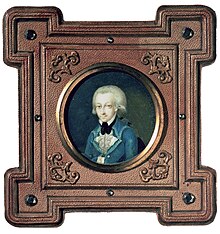| Symphony in G minor | |
|---|---|
| No. 25 | |
| by Wolfgang Amadeus Mozart | |
 Mozart in 1773, portrait by Martin Knoller Mozart in 1773, portrait by Martin Knoller | |
| Key | G minor |
| Catalogue | K. 183/173dB |
| Composed | 1773 (1773) |
| Movements | four |
The Symphony No. 25 in G minor, K. 183/173dB, was written by the then 17-year-old Wolfgang Amadeus Mozart in October 1773, shortly after the success of his opera seria Lucio Silla. It was supposedly completed in Salzburg on October 5, a mere two days after the completion of his Symphony No. 24, although this remains unsubstantiated. Its first movement was used as the opening music in Miloš Forman's biographical film Amadeus.
This is one of two symphonies Mozart composed in G minor, sometimes referred to as the "little G minor symphony". The other is the Symphony No. 40; see also Mozart and G minor.
Movements
The symphony is laid out in standard classical form:
- Allegro con brio,
4 in G minor - Andante,
4 in E-flat major - Menuetto & Trio,
4 in G minor, Trio in G major - Allegro,
4 in G minor
This symphony is scored for two oboes, two bassoons, four horns and strings.
First movement
Second movement
Third movement
Fourth movement
Style and influence
With its wide-leap melodic lines and syncopation, this symphony is characteristic of the Sturm und Drang style. It shares certain features with other Sturm and Drang symphonies of this time, and is likely inspired by Haydn's Symphony No. 39, also in G minor.
Performance history
| This section needs expansion with: performance history in countries other than the United States of America. You can help by adding to it. (May 2020) |
The work was first performed in the United States by the Boston Symphony Orchestra on October 27, 1899, under the direction of Wilhelm Gericke. It was not performed again in the US until 1937, when rendered by the Alfred Wallenstein Sinfonietta. John Barbirolli and the New York Philharmonic performed it again in 1941 as part of their centennial season.
In 1990, Deutsche Grammophon released a recording of this symphony performed by the Vienna Philharmonic Orchestra conducted by Leonard Bernstein, with Peter Schmidl as the principal clarinetist.
In popular culture
The first movement plays over the opening credits of Amadeus, the 1984 Oscar-winning biographical film about Mozart. This version was recorded by The Academy of St. Martin in the Fields and Neville Marriner.
Beginning in the 1990s, the Titan Company (an Indian manufacturer of fashion accessories) released several television advertisements for their Quartz line of watches. Oglivy & Mather, the agency that produced the advertisements, selected a phrase from Allegro con brio as the theme music. These advertisements became iconic and helped popularize the brand. Several versions were produced aside from the traditional arrangement, like one played solely on the piano. Titan also produced an advertisement featuring an electronic backing track overlaid with the theme played on several Indian musical instruments by renowned musicians. These included Ravi Shankar on the sitar and the father-son duo of Alla Rakha and Zakir Hussain on the tabla.
Notes
- Mozart, Wolfgang Amadeus (2005). Die Sinfonien III. Giglberger, Veronika (preface), Robinson, J. Branford (transl.). Kassel: Bärenreiter. pp. XIII. ISMN M-006-20466-3
- Robbins Landon, H. C. (1976). "Haydn at Eszterhaza, 1766–1790". Haydn: Chronicle and Works. Vol. 2. Bloomington, Indiana; London: Indiana University Press.
- Hall, David (1942). Mozart: Symphony No. 25 in G minor (78rpm album set). John Barbirolli and the Philharmonic-Symphony Orchestra of New York. New York: Columbia Records. MX-217.
- "Mozart* - Peter Schmidl, Wiener Philharmoniker, Leonard Bernstein – Mozart Symphonien No. 25 No. 29 Klarinettenkonzert = Clarinet Concerto". Discogs. Retrieved 8 August 2023.
- "Wolfgang Amadeus Mozart – Neville Marriner, Academy Of St. Martin-In-the-Fields – Amadeus (Original Soundtrack Recording)". Discogs. 1984. Retrieved 3 August 2023.
- Yadav, Sneha (May 23, 2019). "BrandSaga: Titan – Timeless Watches, Timeless Ads". Social Samosa. Retrieved 3 August 2023.
- Goel, Shikhar (16 July 2020). "What advertising strategy made TITAN an iconic watch brand?". The Strategy Story. Retrieved 3 August 2023.
External links
- Sinfonie in g KV 183 (173dB): Score and critical report (in German) in the Neue Mozart-Ausgabe
- Symphony No.25 in G minor, K.183/173dB (Mozart, Wolfgang Amadeus): Scores at the International Music Score Library Project
- Symphony No. 25 (Mozart) at the Mutopia Project (the Allegro con brio movement)
- Symphony No. 25 (Mozart) at the Mutopia Project (the Andante movement)
- Symphony No. 25 in G minor mp3 by the RIAS-Symphonie-Orchester Berlin (1950 recording), Liber Liber [it]
- Animated score on YouTube, Weinberger Chamber Orchestra, Gábor Takács-Nagy, live concert, Tonhalle, Zürich, 31 January 2016
| Wolfgang Amadeus Mozart | |||
|---|---|---|---|
| Biography | |||
| Music |
| ||
| Family |
| ||
| Influences | |||
| Related | |||




